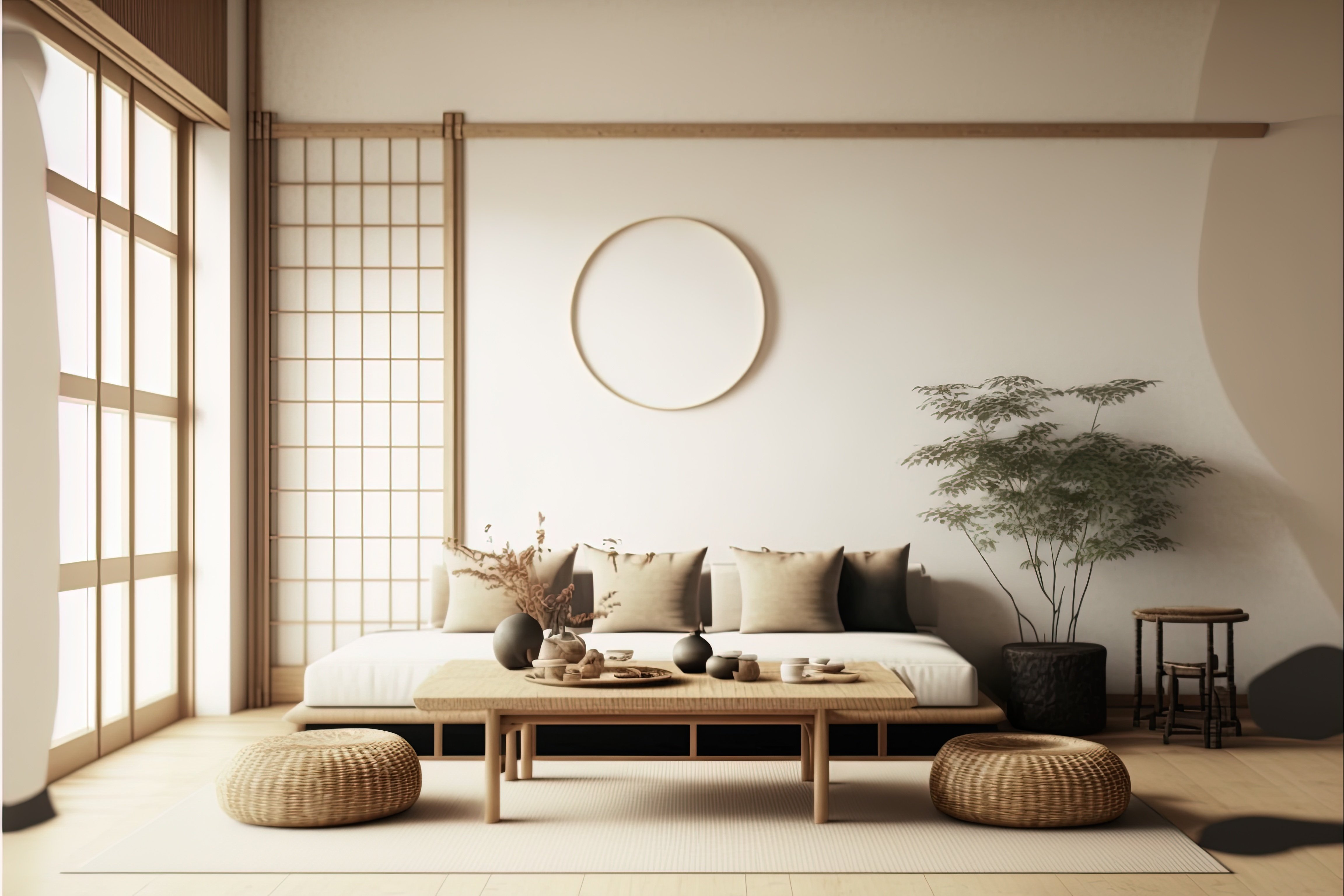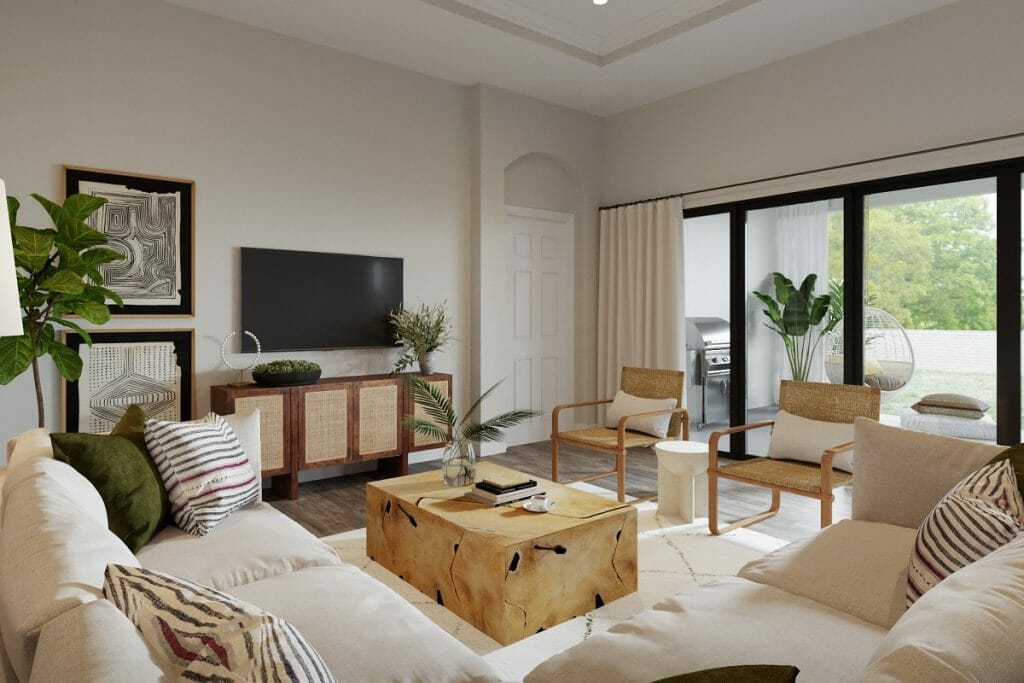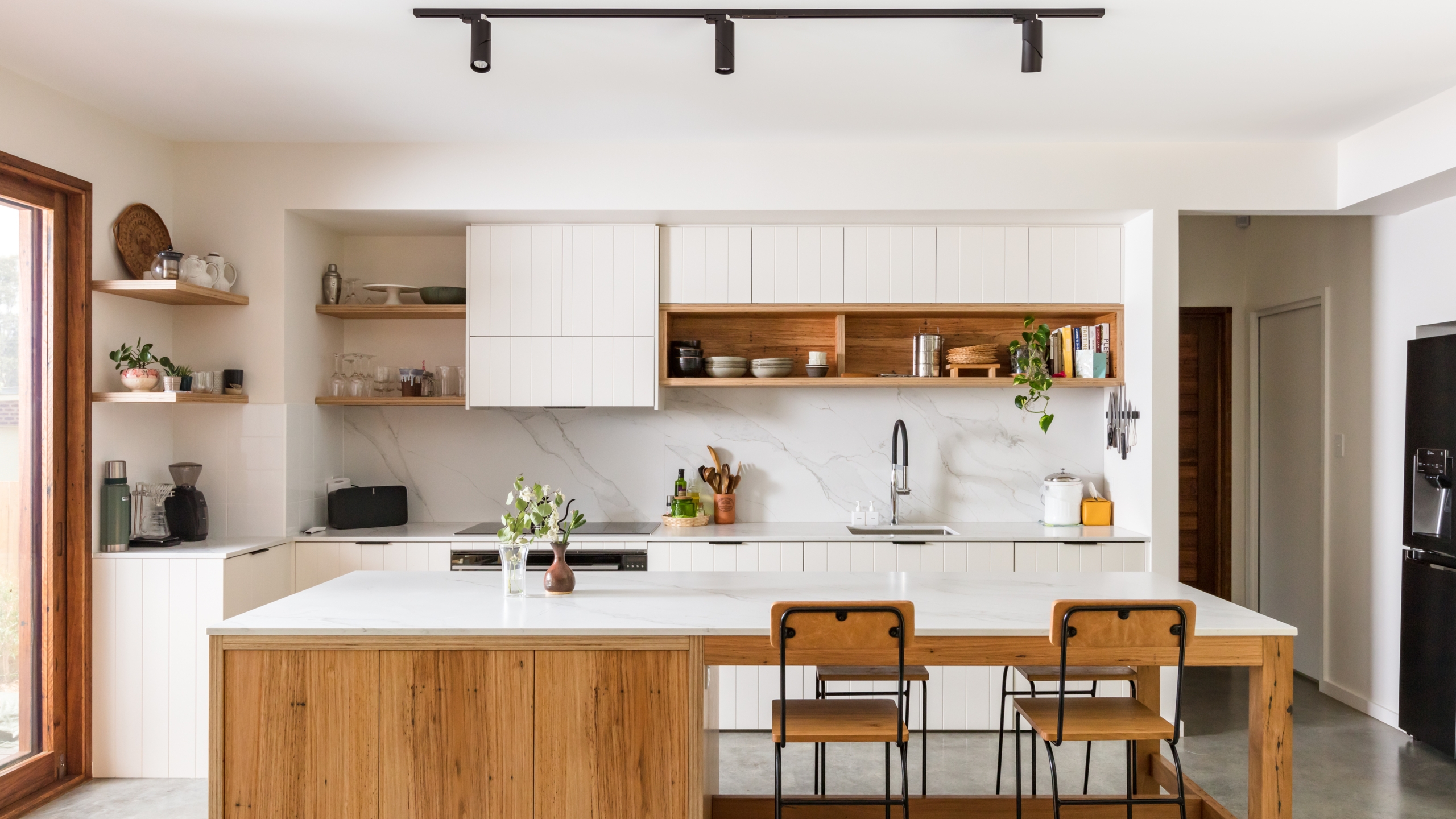Zen & Chic: Japandi Living Room Meets Kitchen
Zen & Chic: Japandi Living Room Meets Kitchen
The open-plan living room and kitchen is a modern classic, offering seamless flow and a sense of spaciousness. But what happens when you infuse this contemporary layout with the calming serenity of Japandi design? The result is a truly enchanting space that blends the minimalist elegance of Japanese aesthetics with the warm, inviting charm of Scandinavian design.
This Japandi living room with kitchen is a sanctuary of tranquility, a haven for relaxation and creativity. It's a space that breathes, where functionality meets beauty, and where every element speaks to a sense of mindful living. Let's explore the key elements that define this unique style and discover how you can bring this harmonious aesthetic into your own home.
The Essence of Japandi Design: A Harmonious Blend
Japandi design, a fusion of Japanese wabi-sabi and Scandinavian hygge, embodies a philosophy of simplicity, functionality, and natural beauty. It embraces imperfections, finds beauty in the natural world, and prioritizes a sense of well-being.
Japanese Influence:
- Minimalism: This design philosophy emphasizes clean lines, uncluttered surfaces, and a focus on functionality.
- Natural Materials: Wood, bamboo, and stone are favored materials that bring a sense of warmth and authenticity.
- Neutral Color Palette: Earthy tones like beige, gray, and white create a sense of calm and tranquility.
- Asymmetry: Japanese design often embraces asymmetrical arrangements, adding visual interest and a sense of balance.
- Wabi-sabi: This aesthetic celebrates the beauty of imperfection, finding elegance in aged and weathered materials.
Scandinavian Influence:
- Hygge: This concept emphasizes coziness, warmth, and a sense of contentment.
- Functionality: Scandinavian design prioritizes functionality and practicality, with an emphasis on well-designed furniture and fixtures.
- Light and Airy: Scandinavian homes are often characterized by abundant natural light and a sense of openness.
- Comfort: Comfortable furniture, soft textures, and inviting details create a welcoming and cozy atmosphere.
The Perfect Blend: Japandi Living Room with Kitchen
The combination of these two distinct styles results in a visually stunning and incredibly practical space. Here's how to achieve this harmonious blend in your own home:
1. Open Floor Plan:
The open-plan layout is key to achieving the spacious and airy feel of a Japandi living room and kitchen. It allows natural light to flow freely throughout the space and creates a seamless transition between the two areas.
2. Neutral Color Palette:
Create a calming and inviting atmosphere by using a neutral color palette. Think soft whites, warm grays, and earthy browns. You can add pops of color with accessories, artwork, or plants.
3. Natural Materials:
Embrace natural materials such as wood, bamboo, rattan, and stone. These materials bring a sense of warmth, authenticity, and connection to nature.

4. Minimalist Furniture:
Choose simple and functional furniture pieces with clean lines and minimal ornamentation. Consider using a combination of wood and upholstered pieces for a balanced look.
5. Storage Solutions:
Keeping your space tidy and organized is crucial for maintaining the Zen-like vibe. Utilize clever storage solutions, such as built-in shelves, cabinets, and drawers, to keep clutter at bay.
6. Lighting:
Lighting plays a crucial role in creating the right atmosphere. Use a combination of natural light and soft, warm artificial light to create a cozy and inviting space. Consider incorporating pendant lights, floor lamps, and table lamps.

7. Plants:
Adding plants is an essential element in Japandi design, bringing a touch of nature and life into the space. Opt for greenery with clean lines and simple forms.
8. Art and Decor:
:max_bytes(150000):strip_icc()/CathieHong-EarthyMckay_30-153aa0232b114809abb0f689935b01f2.jpeg)
Choose artwork and decorative accents that reflect the minimalist aesthetic of Japandi. Consider simple prints, abstract paintings, or minimalist sculptures.
The Japandi Living Room: A Sanctuary of Calm
- Furniture: Choose a comfortable sofa, armchairs, and coffee table that are low to the ground, fostering a sense of relaxation and intimacy. Consider incorporating a traditional Japanese tatami mat for a unique and authentic touch.
- Lighting: Soft, warm lighting is essential for creating a cozy and inviting atmosphere. Consider using dimmable pendant lights over the sofa and table lamps on side tables.
- Storage: Open shelves, baskets, and storage boxes are great for keeping clutter at bay while adding to the minimalist aesthetic. Use them to display books, decorative objects, or plants.

The Japandi Kitchen: Functionality Meets Beauty
- Functionality: The kitchen is the heart of the home, and a Japandi kitchen prioritizes functionality and ease of use. Opt for sleek, minimalist cabinetry, well-organized storage, and high-quality appliances.
- Materials: Use natural materials like wood, bamboo, and stone for countertops, cabinets, and flooring. These materials create a warm and inviting feel.
- Lighting: Natural light is ideal, but you can also use pendant lights over the island and under-cabinet lighting for a more functional and stylish approach.
- Minimalist Details: Keep the kitchen décor simple and elegant. Consider a few carefully curated pieces, such as a wooden cutting board, a hand-thrown ceramic pitcher, or a set of matching ceramic mugs.
Creating Your Own Japandi Living Room with Kitchen
- Start Small: Begin by adding a few Japandi elements to your existing space, such as a bamboo rug, a ceramic vase, or a set of natural fiber placemats.
- Choose a Focal Point: Pick one area in your space and focus on creating a Japandi-inspired look. You can start with the living room, the kitchen, or a specific wall.
- Don't Be Afraid to Experiment: The beauty of Japandi design lies in its flexibility. Don't be afraid to mix and match different styles and elements to create a look that truly reflects your personal taste.
- Seek Inspiration: Browse online, visit design stores, or look at Japandi-inspired home décor magazines for ideas.
Living the Japandi Lifestyle
The Japandi living room with kitchen is more than just a design style; it's a way of life. It's about embracing simplicity, finding beauty in everyday objects, and living with intention. It's about creating a space that is both functional and aesthetically pleasing, a haven for relaxation and creativity.

By incorporating these elements into your own home, you can cultivate a sense of tranquility and mindful living, creating a space that truly reflects your values and priorities.
Here are some additional tips for creating a Japandi living room with kitchen:
- Consider the layout. If your space is small, consider using multi-functional furniture, such as a sofa bed or a dining table that can also be used as a workspace.
- Pay attention to the details. Small details can make a big difference in creating a Japandi aesthetic. Consider using natural fiber textiles like linen, cotton, and wool for curtains, throws, and pillows.
- Use plants to bring nature inside. Plants add life and vibrancy to any space. Choose low-maintenance plants that are easy to care for and thrive in your home's environment.
- Don't be afraid to mix and match. Japandi design allows for a lot of flexibility and experimentation. Mix and match different textures, colors, and materials to create a unique look.

Finally, remember that the most important element of any design is your personal touch. Let your own creativity and individuality shine through. By embracing the principles of Japandi, you can create a home that is both stylish and serene.
Zen & The Art of Kitchen-Living: Japandi Design Takes Over
The modern home is a constantly evolving landscape, reflecting the changing needs and aspirations of its inhabitants. As we seek spaces that are both functional and aesthetically pleasing, a new design philosophy has emerged, captivating the hearts of interior design enthusiasts worldwide: Japandi.
This unique blend of Japanese minimalism and Scandinavian simplicity offers a refreshing alternative to the often-cluttered and overwhelming interiors of the past. Its core values of calm, functionality, and natural beauty translate seamlessly into a living space that feels both serene and inviting, a haven from the chaos of everyday life.
But what happens when this powerful design aesthetic is applied to the heart of the home, the place where practicality and style often collide? We're talking about the kitchen - the space where meals are prepared, families gather, and memories are made.
Zen & The Art of Kitchen-Living:
Japandi design offers a fresh and exciting approach to kitchen design, reimagining the space as a haven of tranquility and understated elegance. By embracing the principles of minimalism, functionality, and natural beauty, Japandi kitchens create a harmonious and inspiring environment for culinary creativity and shared experiences.
The Core Principles of Japandi Kitchen Design:
1. Minimalism:
Japandi kitchens are all about clean lines, uncluttered surfaces, and a streamlined aesthetic. The focus is on essential elements, reducing visual noise and creating a sense of calm.
- Decluttering: The key to a successful Japandi kitchen is minimizing clutter. This means embracing smart storage solutions like drawer organizers, hidden appliances, and minimalist countertop decor.
- Open Shelving: Instead of bulky cabinets, consider incorporating open shelving. This allows for a visual display of your favorite dishes or cookbooks, while also creating a sense of spaciousness.
- Minimalist Hardware: Opt for sleek and understated hardware on cabinets and drawers. Brushed nickel or matte black finishes create a subtle yet elegant touch.
2. Functionality:

Japandi kitchens prioritize efficient layout and practical solutions to facilitate a smooth and enjoyable cooking experience. This means considering the flow of traffic, optimizing workspaces, and incorporating clever storage solutions.
- Work Triangle: The Japandi kitchen layout emphasizes the work triangle - an efficient flow between the sink, stovetop, and refrigerator. This minimizes unnecessary movement, maximizing efficiency.
- Smart Storage: Hidden compartments, pull-out drawers, and multi-functional appliances like a countertop oven or air fryer contribute to a clutter-free and efficient workspace.
- Task Lighting: Strategic lighting is crucial for any kitchen, but especially important in a Japandi space. Task lighting over the stovetop or sink provides focused illumination, while ambient lighting creates a welcoming atmosphere.
3. Natural Beauty:
Japandi kitchens celebrate the beauty of natural materials and earth tones. This creates a warm and inviting ambiance, fostering a connection with nature and promoting a sense of well-being.
- Wood: The cornerstone of Japandi design is wood. Look for light-colored woods like oak or birch, and incorporate them in cabinets, countertops, flooring, or even a wood-framed kitchen island.
- Stone: Natural stone, such as granite or marble, adds a touch of sophistication and durability. These materials can be used for countertops, backsplashes, or even flooring.
- Earthy Color Palettes: A muted color palette of white, beige, gray, and soft blues or greens creates a sense of peace and tranquility.
- Natural Textures: Incorporating natural textures through woven baskets, linen curtains, or even a live herb garden adds warmth and depth to the space.
Creating a Japandi Kitchen Oasis:

1. The Color Palette:
The Japandi color palette is characterized by neutral shades that evoke a sense of calm and serenity. Think soft whites, creamy beiges, warm grays, and subtle earth tones. These colors create a backdrop for the natural materials and minimalist elements that define the style.
- Whites & Creams: These versatile colors bring a sense of light and spaciousness to the kitchen. White cabinets and walls can be paired with warm cream-colored countertops or wooden accents for a balanced look.
- Greys & Blues: For a touch of sophistication and a calming effect, incorporate shades of gray or soft blue into the kitchen. These colors work well for accents, like a painted island or a statement backsplash.
- Earthy Tones: Embrace the natural beauty of wood with warm browns, or add a touch of earthy green through plants or accessories.
:max_bytes(150000):strip_icc()/CathieHong-EarthyMckay_30-153aa0232b114809abb0f689935b01f2.jpeg)
2. Furniture & Fixtures:
The right furniture and fixtures can elevate your Japandi kitchen from ordinary to extraordinary.
- Kitchen Island: A kitchen island serves as both a functional workspace and a gathering place. Choose a simple design in natural wood with a minimalist countertop.
- Bar Stools: Pair your kitchen island with sleek bar stools in natural materials like wood or cane.
- Lighting: Pendant lights over the island or sink create a focal point, while task lighting provides ample illumination for cooking and preparing meals.

3. Natural Elements:
Japandi design thrives on the beauty of nature.
- Houseplants: Plants bring life and freshness to any space, and are especially impactful in a Japandi kitchen. Opt for low-maintenance plants like succulents, snake plants, or ZZ plants.
- Natural Materials: Incorporate elements like woven baskets, linen curtains, or even a wooden cutting board into your kitchen decor.
- Art: Artwork with a minimalist aesthetic and natural themes can enhance the overall feeling of peace and serenity.
Beyond the Kitchen:
Japandi principles can be seamlessly integrated into other living spaces, creating a cohesive and harmonizing atmosphere throughout the home.
- Living Room: A Japandi living room features minimalist furniture, light-colored walls, and natural materials like wood and linen.
- Bedroom: The Japandi bedroom prioritizes a sense of calm and tranquility, with soft colors, natural textures, and ample storage.
- Bathroom: A Japandi bathroom is a sanctuary of serenity, with clean lines, minimal accessories, and natural elements like bamboo or stone.

Japandi: More Than Just a Trend:
Japandi design is more than just a fleeting trend; it's a lifestyle choice that promotes mindfulness, simplicity, and a connection to nature. By embracing its core values, you can create a home that is both functional and aesthetically pleasing, a space that reflects your personal style and promotes a sense of well-being.
The Japandi kitchen, in particular, is a testament to the power of this design philosophy. By blending the practicality of Scandinavian design with the serenity of Japanese aesthetics, it offers a fresh and inviting approach to one of the most essential spaces in the home.

As you create your own Japandi kitchen oasis, remember to embrace the core principles of minimalism, functionality, and natural beauty. This will ensure that your space is not only beautiful, but also a reflection of your unique style and a haven for peace and tranquility. .


